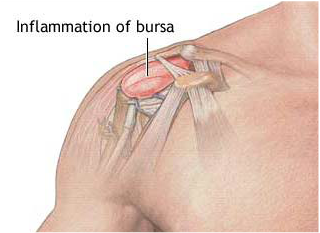Shoulder Bursitis
|
Bursitis is inflammation of the bursa (or bursae, plural), a fluid-filled sac rich in collagen and proteins that cushions and reduces friction between the bones, tendons and muscles near the joints.
Shoulder bursitis, as the name suggests, is inflammation or injury to the shoulder or subacromial bursa. but is also common in the other major bursae located near the hips, elbows, knees and heels.
|
Causes of Shoulder Bursitis
Risk factors for shoulder bursitis include
- Strenuous or repeated physical activity, i.e throwing a ball, lifting heavy objects.
- Injury, i.e, a fall onto the shoulder.
- An underlying rheumatic/arthritic condition such as pseudogout or gouty arthritis.
- Infection (rare in the shoulder).
Symptoms of Shoulder Bursitis
- Pain
- Heat
- Redness
- Swelling
- Stiffness
- Restricted movement.
Bursitis often develops quickly, over a period of a couple of days and can be accompanied by rotator cuff tendinitis in the tendons adjacent to the affected bursa in the shoulder. It can also cause a "pinching" pain when the elbow is moved away from the body, referred to as an "impingement" sign.
Chronic (long-term) bursitis that is left untreated can result in a build up of calcium deposits (calcific bursitis) in the soft tissues, resulting in permanent loss of movement to the area.
Severe loss of motion in the shoulder called "adhesive capsulitis" (frozen shoulder) can also result from the immobility and pain associated with shoulder bursitis.
Treatment for Shoulder Bursitis
- Avoiding activities that aggravate the problem.
- Resting the injured area.
- Icing the area the day of the injury to reduce swelling.
- Taking over-the-counter anti-inflammatory medicines.
- Cortisone (steroid) injections into the affected area.
- Occasionally, the fluid may need to be aspirated (removed using a needle and syringe) from the affected bursa in order to relieve pressure. This may need to be done more than once and can be performed in a doctors surgery.
- Physiotherapy - incorporating a range-of-motion exercises. Physiotherapy is very effective especially when your bursitis is accompanied by a frozen shoulder.
Infectious (septic) bursitis, which is uncommon in the shoulder, requires even further evaluation and aggressive treatment from a medical practitioner.
The Outlook for Shoulder Bursitis
Shoulder bursitis generally makes a full recovery and often resolves within a couple of weeks as long as the shoulder is rested as soon as the symptoms start. Rest here means not subjecting the shoulder to the same activity that caused the injury (if it can be identified) or any activity that aggravates the pain – especially overhead movement.
You should however, continue to use the shoulder in everyday activities as much as possible to prevent the muscles that support the shoulder from weakening. Just don't ignore any pain because you will cause more inflammation and delays in healing.
If the bursitis is accompanied by scarring around the shoulder joint (adhesive capsulitis), it can require long-term physical therapy. It is better to seek diagnosis and treatment of your symptoms early to avoid complications.
How to avoid Shoulder Bursitis
Bursitis of the shoulder can be prevented by avoiding overuse through excessive straining of the shoulder. especially repetitive over the head activities.
If exercising, gradually build up force and repetitions. Stop what you are doing if unusual pain occurs.
If exercising, gradually build up force and repetitions. Stop what you are doing if unusual pain occurs.
Stretching exercises help prevent stiffness of the shoulder. Strengthening exercises for the rotator cuff (the group of four muscles and their tendons, which support the shoulder joint during movement) can help prevent stiffness and stabilize the shoulder, which in turn can help prevent soft tissue injuries such as shoulder bursitis from recurring.
At NorthWest Physio + we can assess your symptoms, diagnose your injury and advise you on the appropriate treatment needed.

